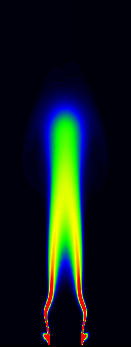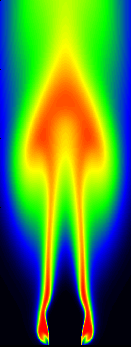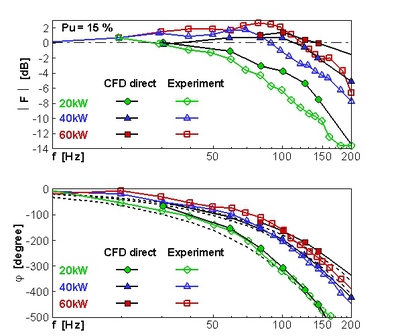Unsteady turbulent premixed flames
Example: Calculation of a pulsed turbulent premixed jet flame
Premixed flames are increasingly used in industrial combustion systems in order to minimise the thermal NOX emission levels. As a major disadvantage, premixed combustion often leads to self-sustained combustion instabilities which are combined with the formation of ring-vortices. The video shows the result (temperature Field) of an URANS-calculation of an unconfined turbulent premixed jet flame. The mass flow of the stoichiometric fuel/air mixture at the burner nozzle was pulsed sinusiodally. At every acceleration phase a coherent large-scale ring-vortice near the burner outlet forms and flows downstream. The vortices influence the dynamical behaviour of the flame. Background of the investigation is the prediction of instabilities in combustion systems.
Parameters: nozzle diameter = 26 mm, mean velocity = 24.4 m/s, pulsation frequency = 100 Hz
Conversion rate Temperature



In the study premixed free burning premixed turbulent jet flames with three different thermal loads (20/40/60 kW) were modelled. The calculations were done with a CFD-code based on the URANS-approach and using the k-e turbulence model and a TFC combustion model.
The figure shows calculated flame transfer functions in comparison to measurements from literature. Turbulent flames (stoichiometric methane/air-mixture) with different thermal loads have been investigated (Parameters: nozzle diameter = 26 mm, mean velocity = 12/24/36 m/s, pulsation frequency = 100 Hz, pulsation level = 15%).
The upper picture shows the comparison of the amplitude responses, the lower picture the appropriate phase angles.
The amplitude decreases and the phase angle increases for increasing pulsation frequency. The effect is the larger, the lower the thermal load is. The measured amplitude responses are typically smaller than the calculated. This discrepancy is mainly caused by mixture effects. Because the ring-vortices involve an entrainment of ambient air into the reaction zone the temperature decreases and so does the amplitude of the OH-radiation signal. As in the simulation the reaction rate is analysed, this effect does not apply, which leads to a smaller amplitude reduction. The coincidence between calculated and measured phase angles is nearly perfect. The black dashed lines show some phase angle functions obtained with a model where the flame is seen as an idle-time element with a distributed dead time.
The results show that the URANS-approach is useful to predict the flame transfer function (FTF) of the flames up to frequencies of 200 Hz. The main conclusion of the work is, that the considered flames exhibit the same dynamical behaviour as an idle-time element with a distributed dead time.
References
Matthias Hettel, Peter Habisreuther, Max Weiß, Henning Bockhorn, Nikos Zarzalis, (2005). URANS-Modelling of Pulsed Turbulent Jets and Premixed Jet Flames. Progress in Computational Fluid Dynamics (PCFD), 5, 386-397
Matthias Hettel, Peter Habisreuther, Henning Bockhorn, (2005). Unsteady Reynolds-Averaged Navier-Stokes (URANS) - Modeling of Flame Transfer Functions of Turbulent Premixed Jet Flames (Paper: 670), Proceedings of Twelfth International Congress on Sound and Vibration (ICSV12).
